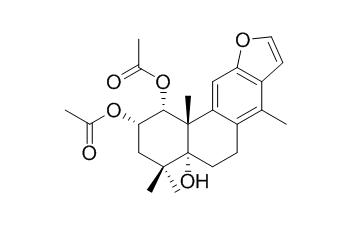2-Acetoxy-3-deacetoxycaesaldekarin E
2-Acetoxy-3-deacetoxycaesaldekarin E shows significant dose-dependent inhibitory effects on Plasmodium falciparum FCR-3/A2 growth in vitro.
Inquire / Order:
manager@chemfaces.com
Technical Inquiries:
service@chemfaces.com
Tel:
+86-27-84237783
Fax:
+86-27-84254680
Address:
1 Building, No. 83, CheCheng Rd., Wuhan Economic and Technological Development Zone, Wuhan, Hubei 430056, PRC
Providing storage is as stated on the product vial and the vial is kept tightly sealed, the product can be stored for up to
24 months(2-8C).
Wherever possible, you should prepare and use solutions on the same day. However, if you need to make up stock solutions in advance, we recommend that you store the solution as aliquots in tightly sealed vials at -20C. Generally, these will be useable for up to two weeks. Before use, and prior to opening the vial we recommend that you allow your product to equilibrate to room temperature for at least 1 hour.
Need more advice on solubility, usage and handling? Please email to: service@chemfaces.com
The packaging of the product may have turned upside down during transportation, resulting in the natural compounds adhering to the neck or cap of the vial. take the vial out of its packaging and gently shake to let the compounds fall to the bottom of the vial. for liquid products, centrifuge at 200-500 RPM to gather the liquid at the bottom of the vial. try to avoid loss or contamination during handling.
Sci Rep.2019, 9:19059
FASEB J.2019, 33(2):2026-2036
BMC Complement Altern Med.2019, 19(1):339
Phytomedicine2022, 104:154318
Phytomedicine.2020, 153440.
UDC.2020, 19(4).
Molecules.2021, 26(8):2161.
Food Chem.2018, 252:207-214
Bulletin of Health Research2016, 44(4):279-286
Anal Bioanal Chem.2016, 408(1):177-90.
Related and Featured Products
J Nat Prod. 2005 May;68(5):706-10.
Cassane- and norcassane-type diterpenes from Caesalpinia crista of Indonesia and their antimalarial activity against the growth of Plasmodium falciparum.[Pubmed:
15921414]
METHODS AND RESULTS:
The CH2Cl2 extract of the seed kernels of Caesalpinia crista, which exhibited promising antimalarial activity against Plasmodium berghei-infected mice in vivo, was examined and resulted in the isolation of seven new furanocassane-type diterpenes [caesalpinins C-G (1-5) and norcaesalpinins D and E (6, 7)] together with norcaesalpinins A-C (8-10) and 11 known compounds (norcaesalpinins A-C, 2-Acetoxy-3-deacetoxycaesaldekarin E, caesalmin B, caesaldekarin e, caesalpin F, 14(17)-dehydrocaesalpin F, 2-acetoxycaesaldekarin e, 7-acetoxybonducellpin C, and caesalmin G). Their structures were determined on the basis of spectroscopic analysis.
CONCLUSIONS:
The isolated diterpenes showed significant dose-dependent inhibitory effects on Plasmodium falciparum FCR-3/A2 growth in vitro. Their IC50 values ranged from 90 nM to 6.5 microM, and norcaesalpinin E (7) showed the most potent inhibitory activity (IC50, 90 nM).



